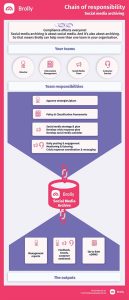January is a great time to review and refresh your social media policy to ensure you have what you need to succeed with social media this year.
A social media policy is more than guidelines. It’s an organisation’s clearly articulated position on how their social media should be run, to stay compliant with relevant legislation, uphold the organisation’s brand and reputation and align with the communications strategy. If you don’t already have a policy in place, there are some great templates available for free.
A social media policy can apply to:
- the social media or marketing team and relate to the organisation’s social media accounts, or
- general employees, and relate to what they should consider, as employees, when they use their own private accounts.
This article is about the kind of social media policy that will be used by the social media team to manage an organisation’s social media.
The employee-private-accounts type of policy is often called a Social Media Usage Policy and we’re not covering it here. Again, Google can be your friend as you search for that…
A social media policy is a kind of insurance
Smaller teams often do without a social media policy, putting it low on the priority list. The problem with that approach is that a policy is a little bit like insurance: you don’t need insurance until something bad happens and you need to make a claim. In the same way, you don’t need a social media policy until there’s an issue.
What should be in a social media policy
If you Google as we suggested above, you’ll find that there’s a huge variation in the exact content. What they all have in common is the idea of looking after your brand, keeping your staff safe and giving them the confidence to understand what to do if something happens that isn’t okay.
Who is the social media policy for?
Be clear about who the policy is for. For example, if your policy is for your social media team, state that up front. Don’t assume it’s obvious. For this example, we’re going to go with ‘social media team’ as the audience. Your organisation may call this group of expert communicators something different, of course!
Include social media archiving in your statement and scope
Your policy’s statement and scope section is really the main part of your policy. It’s the section where the organisation’s requirements and constraints around social media are clearly stated.
In our research, we see that most social media policies include policy statements for:
Publishing approvals. Who can publish and what approvals are required, if any. If approvals are required, who is the approver? Keep in mind that you might need different approvers for different content. An example might be the approvals required for an emergency notification to a customer service message.
Copyright. Copyright law can seem complicated, unless your team has studied it in depth. Use your social media policy to be clear about what they can and can’t do when it comes to re-use, sharing and ‘borrowing’ content from the internet.
Content to avoid. If there are any message or information types that your social media team should avoid publishing on social media, make sure they are clearly listed here.
Editing and deleting. It’s a fact of life that social media posts may sometimes need to be edited or deleted. If you’re addressing this in your social media policy, make sure to detail the circumstances in which it is okay (or required) to edit or delete, and your policy about archiving to ensure those deleted posts aren’t lost forever (Hint: you do need to archive social media, to ensure you’ve captured deleted posts and edits.)
Social media archiving. For government and for organisations in regulated sectors such as financial services, health or education, social media records must be archived in order to comply with legislation. Make sure your policy includes a clear statement about what records need to be archived.
Crisis and emergency communications. If your organisation uses social media to send out messages in the event of a crisis or emergency, your social media policy should be clear about who is responsible for social media tasks and approvals during these events. Be extra clear in this section because people in crisis find it more difficult to absorb information. Keep in mind that your social media policy is not the place to detail your crisis plan, but should instead refer to it and tell people where to find the most up to date version.
Who does what
Think about the social media-related tasks of all the people to whom the policy applies, and list them. Make sure there is one role identified who has the main responsibility for each of the items on the list. A great way to show this clearly on a page is to create a table with two columns (see below)
One column lists what needs to be done, and the other column lists who is responsible. Sometimes this is called a Roles and Responsibilities table.
After listing all the social media related tasks match each with a role. We’ve used the Hootsuite article on Social Media Policies as a starting point for our list and we’re sure they won’t mind if you do that too.
Hint. When assigning roles to responsibilities, avoid using names. Instead use positions or titles, e.g. Social Media Manager, Social Media Coordinator, Director, Communications specialist, Records Manager etc. When a task is the responsibility of a whole team, and make sure the team has an internal process to assign a chain of responsibility.
For social media a good example of this might be that the Records Management team is responsible for uploading archived records to the EDRMS. Another example is that the IT Department might hold the logins for the platforms you use to schedule posts or archive social media records.
What do we know about social media archiving?
We’re the first to admit that Brolly’s social media channels aren’t the most active in the universe. Our expertise comes from a deep understanding of the risk associated with not archiving your social media. We work with customers from all levels of government, from schools, universities, and the corporate sector, to understand and mitigate the risk. In fact that’s our core activity; our reason for existence. What we’ve discovered is that for most organisations, the process of capturing social media records into an archive is not always about record keeping compliance. The right social media archiving tool can mitigate of the risks of damage to your brand and reputation with the ability to monitor and act quickly.
 Schools and colleges
Schools and colleges Banking and financial services
Banking and financial services Health providers
Health providers





